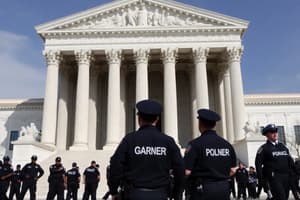Podcast
Questions and Answers
What did the Supreme Court rule regarding the use of deadly force to prevent the escape of a suspect?
What did the Supreme Court rule regarding the use of deadly force to prevent the escape of a suspect?
- It can be used if the suspect is fleeing a misdemeanor.
- It is unconstitutional unless there is probable cause of a significant threat. (correct)
- It can be used at the officer's discretion regardless of the situation.
- It is acceptable in all cases.
What was the main constitutional issue addressed in Tennessee v. Garner?
What was the main constitutional issue addressed in Tennessee v. Garner?
- Fifth Amendment right to due process.
- Eighth Amendment prohibition against cruel and unusual punishment.
- First Amendment right to free speech.
- Fourth Amendment protection against unreasonable seizures. (correct)
In the context of this ruling, how is 'proportionality' defined?
In the context of this ruling, how is 'proportionality' defined?
- The necessity for officers to use lethal force regardless of circumstances.
- The force used must be commensurate with the threat presented. (correct)
- The requirement for public approval of police actions.
- The relationship between the officer's rank and the situation.
What situation did Edward Garner find himself in that led to the Supreme Court case?
What situation did Edward Garner find himself in that led to the Supreme Court case?
What must officers consider before using deadly force?
What must officers consider before using deadly force?
How does the ruling affect police policies on the use of force?
How does the ruling affect police policies on the use of force?
What was the critical error in the Tennessee statute regarding police use of force?
What was the critical error in the Tennessee statute regarding police use of force?
What principle emphasizes the necessity for actions by police to reflect the actual threat posed?
What principle emphasizes the necessity for actions by police to reflect the actual threat posed?
Which of the following statements reflects a key finding of the Supreme Court in this case?
Which of the following statements reflects a key finding of the Supreme Court in this case?
What primary change did the Garner decision prompt regarding police use of force?
What primary change did the Garner decision prompt regarding police use of force?
Which of the following areas has been influenced by the Garner ruling?
Which of the following areas has been influenced by the Garner ruling?
What ongoing debates are shaped by the Garner decision and its subsequent interpretations?
What ongoing debates are shaped by the Garner decision and its subsequent interpretations?
Why has police training on the use of force become essential across police academies?
Why has police training on the use of force become essential across police academies?
What is a key aspect that the Garner decision has clarified regarding police practices?
What is a key aspect that the Garner decision has clarified regarding police practices?
What broad implication did the ruling have for police practices?
What broad implication did the ruling have for police practices?
How has the Garner ruling affected litigation concerning police practices?
How has the Garner ruling affected litigation concerning police practices?
What limitation has the Garner ruling imposed on police actions?
What limitation has the Garner ruling imposed on police actions?
What effect has the Garner decision had on police department policies?
What effect has the Garner decision had on police department policies?
What has been a significant response from police academies post-Garner ruling?
What has been a significant response from police academies post-Garner ruling?
Flashcards
Deadly Force Limitations
Deadly Force Limitations
The use of deadly force by law enforcement is only permissible when necessary to prevent a suspect from posing a threat of serious physical harm to officers or others.
Impact of Garner Decision
Impact of Garner Decision
The Garner ruling significantly restricted the use of deadly force by police, particularly when apprehending fleeing suspects.
Police Policy Revisions
Police Policy Revisions
Police departments have revised their policies and procedures regarding the use of force to comply with the Garner standards.
Police Training on Deadly Force
Police Training on Deadly Force
Signup and view all the flashcards
Subsequent Case Developments
Subsequent Case Developments
Signup and view all the flashcards
Ongoing Debates on Use of Force
Ongoing Debates on Use of Force
Signup and view all the flashcards
Potential Litigation
Potential Litigation
Signup and view all the flashcards
Mandatory Police Training
Mandatory Police Training
Signup and view all the flashcards
Policy Compliance
Policy Compliance
Signup and view all the flashcards
National Impact of Garner Decision
National Impact of Garner Decision
Signup and view all the flashcards
Tennessee v. Garner
Tennessee v. Garner
Signup and view all the flashcards
Deadly Force for Fleeing Suspects
Deadly Force for Fleeing Suspects
Signup and view all the flashcards
Probable Cause
Probable Cause
Signup and view all the flashcards
Proportionality of Force
Proportionality of Force
Signup and view all the flashcards
Fourth Amendment Application
Fourth Amendment Application
Signup and view all the flashcards
Alternatives to Deadly Force
Alternatives to Deadly Force
Signup and view all the flashcards
Fleeing Suspect Alone is Insufficient
Fleeing Suspect Alone is Insufficient
Signup and view all the flashcards
Objective Reasonableness
Objective Reasonableness
Signup and view all the flashcards
Officer's Assessment
Officer's Assessment
Signup and view all the flashcards
Necessity for Consideration of Alternatives
Necessity for Consideration of Alternatives
Signup and view all the flashcards
Study Notes
Case Overview
- Tennessee v. Garner, 471 U.S. 1 (1985), addressed the legality of deadly force by police during arrests.
- The Supreme Court ruled police cannot use deadly force to stop a fleeing suspect unless there's probable cause to believe the suspect poses a significant threat of death or serious physical injury to the officer or others.
Facts of the Case
- Edward Garner fled from police.
- An officer shot Garner in the back as he climbed over a fence.
- Garner was unarmed.
- Garner died from the gunshot wound.
- Tennessee law allowed deadly force to stop any fleeing felony suspect.
Legal Issues
- Was the Tennessee statute authorizing use of deadly force to prevent a fleeing felony suspect's escape constitutional under the Fourth Amendment?
Supreme Court's Ruling
- The Supreme Court deemed the Tennessee statute unconstitutional.
- The Court established that using deadly force in such circumstances is unreasonable unless the suspect poses a significant threat.
- The Court emphasized that a suspect's flight alone does not justify deadly force.
Key Principles of the Ruling
- Fourth Amendment prohibition of unreasonable seizures applies to all instances of police deadly force.
- Deadly force use must be objectively reasonable under the circumstances by a reasonable officer.
- The force used must be proportional to the threat.
Proportionality and Reasonable Force
- Proportionality means the force used must match the threat.
- Using deadly force must be objectively reasonable, as judged by a reasonable officer on the scene.
Application and Implications
- Officers must carefully assess the situation's potential threat before considering deadly force.
- Alternatives to deadly force, if available, should be considered.
- This ruling impacted police practices, requiring training, policy changes, and potential litigation.
Subsequent Cases and Developments
- Garner influenced police practices and policies concerning force.
- Subsequent cases refined the circumstances allowing for deadly force.
- Debates around standards for "reasonable use" of force continue.
Impact on Law Enforcement
- Garner restricted the use of deadly force.
- Police departments revised use-of-force policies.
- Training on force limitations became crucial for police academies.
Studying That Suits You
Use AI to generate personalized quizzes and flashcards to suit your learning preferences.




